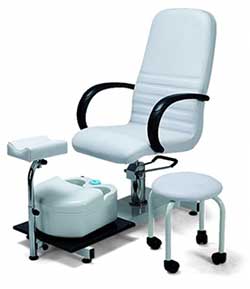A pedicure chair is a type of seating primarily used in spas and nail salons that is specifically designed and engineered to facilitate foot care, allowing a technician to wash the feet, remove dead skin, and tend to nail care.
While they vary widely in appearance, all pedicure chairs have three basic elements in common:
Note: The larger chairs also have a dedicated pedestal-style base that the chair itself rests on (see pictures below), but this isn’t a universal trait.

Main Usage of Pedicure Chairs
These are highly specialized pieces of equipment and are overwhelmingly found in spas and nail salons, although a small percentage of them are also in use by mobile pedicure providers operating primarily out of vans.
Even if you wanted one for home use, most people just don’t have enough space unless you have an enormous house, an entire room you’re not using, or want to turn your garage into a private pedicure station.
That’s not to say that home users don’t have options. Of course, they do, it’s just that you don’t often find pedicure chairs in most home environments. Consider these devices to be a very specific type of office equipment.
Different Types of Pedicure Chairs
Broadly speaking, there are only two basic “types” of pedicure chairs: Piped-in and Pipeless.
A piped-in chair is fully plumbed, with water flowing into the bowl from your building’s plumbing system. At first glance, you might think that these are the way to go, but the reality is that piped-in chairs aren’t as sanitary, because few spas and nail salons take the time to properly clean the insides of the pipes running into and out of the chair.
That’s problematic, because after a pedicure, the water in the bowl is unsanitary, filled with dead skin, bacteria, and possibly fungus, and that leads to buildups of bacteria in the piping, which can cause infections if other customers are exposed to them.
In response to the enormous challenges of keeping the pipes clean, pipeless chairs were invented.
In this rendering of the device, water is poured into the bowl manually (or from a dedicated water tank) for each customer, then taken away to be disposed of. Since the salon or spa is only having to deal with keeping the bowl itself clean, it’s a much easier task, and the net result is a much safer, more sanitary environment.
Needless to say, although piped-in chairs still exist, they have slowly and steadily been falling out of use in preference for pipeless chairs, which are simply safer and easier to clean and maintain.
Technically, you could say that chairs designed for mobile use represent a third type of pedicure chair. These are typically collapsible, so they can be carried to different locations (retirement communities, assisted living centers, and the like), but in practice, they’re simply smaller, more easily moved variants of pipeless chairs, so again, broadly speaking, our classification above holds true.
With only two types of chairs to choose from, and one of them being decidedly out of favor, you might think that there’s not a lot of choice or variation in the world of pedicure chairs. Nothing could be further from the truth! There are a dizzying array of possible features and feature combinations on offer, and this is where you see the biggest variance.
So what kind of features can you expect to find on today’s pedicure chairs? They include things like:
And more!
In addition to those things, pedicure chairs come in a variety of footprint sizes. If you’re looking to maximize the number of chairs you can comfortably fit into a small shop space, you could gravitate toward chairs with the smallest possible footprint. If you’ve got more space, you can get larger, more elaborate chairs and spread things out a little, or make use of a combination of both.
Some companies even make brightly colored, kid-sized pedicure chairs that come with DVD players so your children can enjoy a pedicure while you’re getting yours. And of course, pedicure chairs come in an unbelievable number of upholstery options, so you’re sure to be able to find one that perfectly fits your needs and meshes seamlessly with your shop’s’ décor.
Pictures of Pedicure Chairs
Here are some pictures of some of the pedicure chairs on the market today:







Origin and History of Pedicure Chairs
There are ancient Egyptian hieroglyphs showing Pharos and members of the Royal Court getting pedicures, so the practice of getting one dates back literally thousands of years.
The idea of a highly specialized chair designed to facilitate a pedicure is much more recent, and dates back to the 1980’s, and can be traced to a Russian immigrant named John Meyerovich, who designed the modern pedicure chair in his garage.
During the 1980’s, salons were still very much a niche business, but in the 2000’s, they became much more mainstream and the industry experienced tremendous growth. As that happened, the number of companies offering pedicure chairs, and the number of styles and options available exploded.
Some Current Brands of Pedicure Chairs
Confused yet? There are a staggering number of pedicure chairs on the market today, offered by a wide variety of manufacturers. In our view, here are some of the best to consider. These companies offer a whole range of products, and all are worth taking a closer look at:







